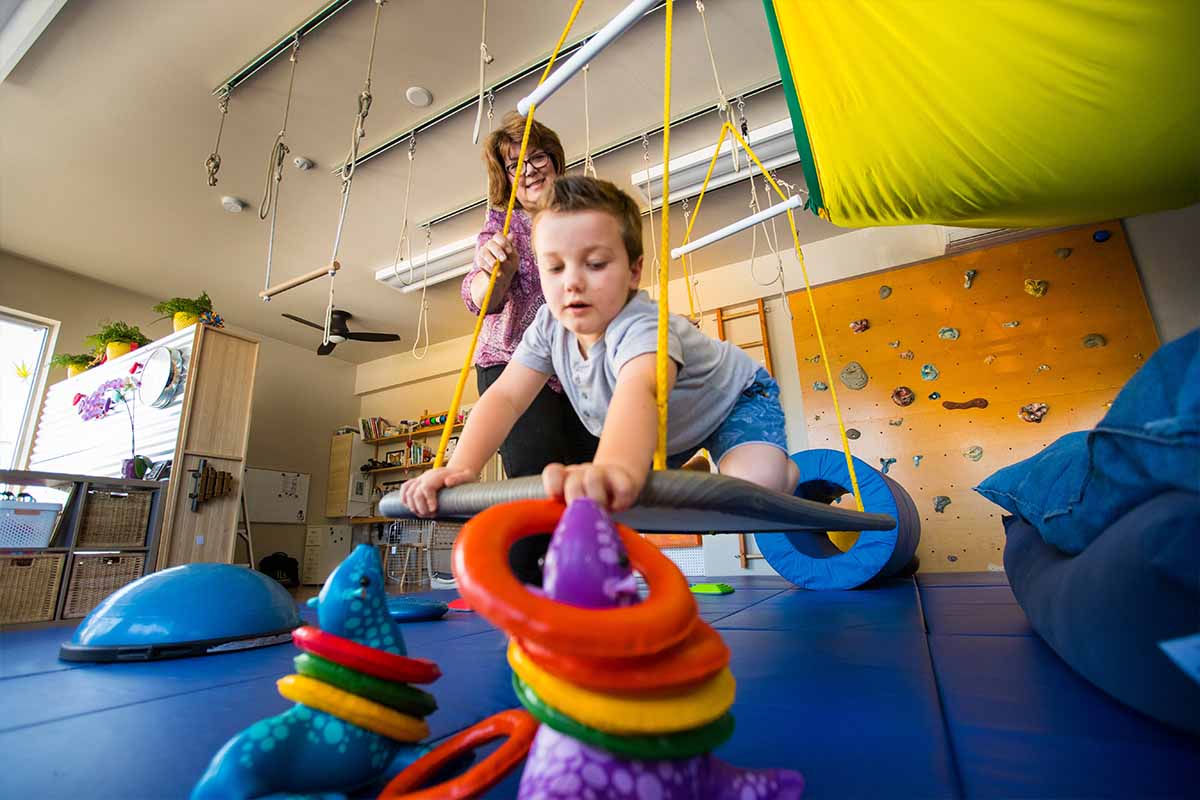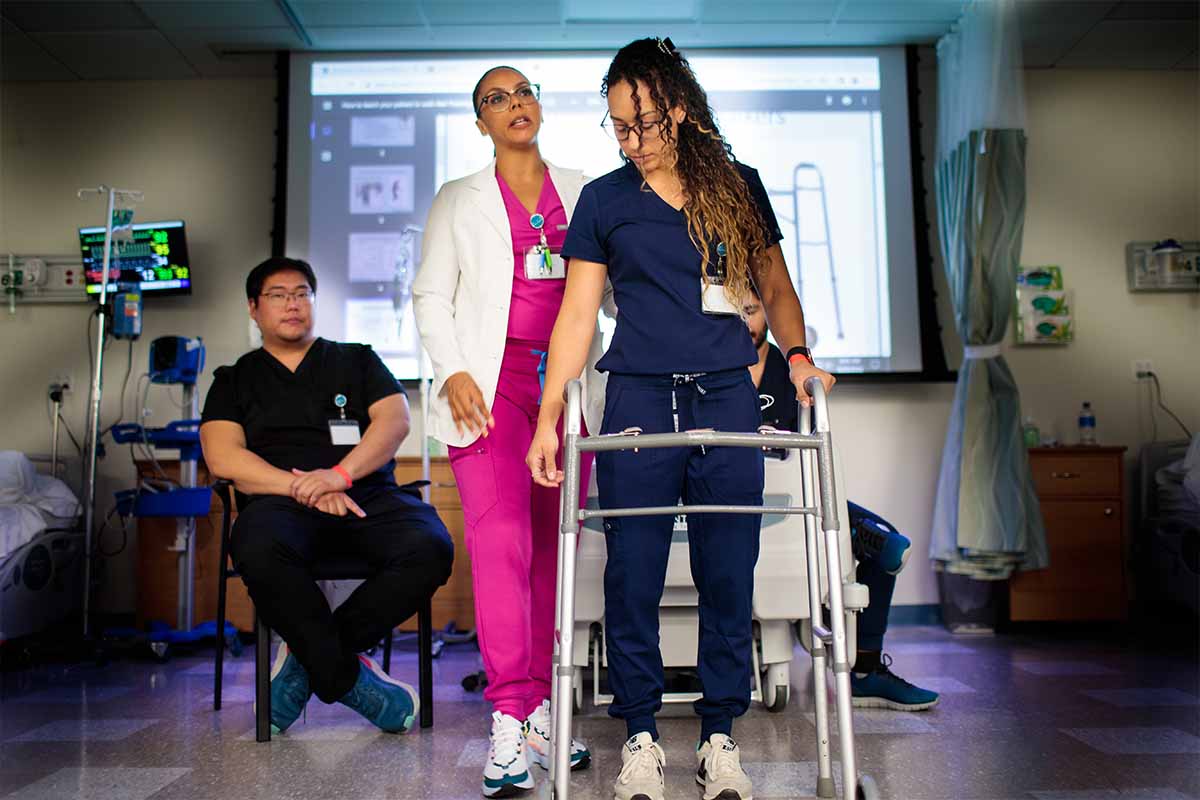At the pro bono pediatric clinic on the USAHS Austin campus, occupational therapy students have the chance to help children with learning and physical differences develop their skills. It’s a program with benefits for students, children, and families.
Gina Benavente, DHSc, MPH, OTR, an assistant professor in the Master of Occupational Therapy (MOT) program in Austin, founded the pediatric clinic in 2016. “Families volunteer to bring their children in who have an identified OT need,” she explains. “Our students have the chance to evaluate the children, interview the parents, and develop an intervention plan. They implement that plan over the course of several weeks.” Students practice, children learn, and USAHS gives back to the local community.
Real life, community pro bono pediatric clinic prepares students for a career in OT
Straddling Between Pro Bono and Simulation
Dr. Benavente teaches Clinical Applications in Pediatrics/Adolescence, a required course that’s offered every trimester in the MOT and Doctor of Occupational Therapy (OTD) programs. Although each USAHS campus has its own approach, in Austin, this course is embedded as Level I Fieldwork. All students work in the clinic for their Level I Fieldwork experience, supervised by faculty members who are licensed OTs.
Faculty sometimes call it a “mock clinic” because it simulates a real-life outpatient clinic rather than actually being one. It’s open only during class time for four or five weeks each trimester, it’s not a freestanding facility, clients aren’t billed, and medical referrals aren’t needed. Dr. Benavente describes the clinic as “straddling between pro bono and simulation.”
The clinic advertises locally to find clients. Participants range in age from toddlers to teenagers. Some of the same families have been coming for years, and new people come in every session. Many of the families don’t have insurance and can’t afford occupational therapy, so the clinic fills a gap in needed services.
The clinic is also a place where OT students gain hands-on experience with clients earlier than most programs incorporate this step. “We have a unique approach here—we place a high value on student experience,” Dr. Benavente says. “We go above and beyond Level I Fieldwork standards, which are about students observing in the community. Our Level I students are actually working with real patients.”
Teaching a Range of Skills

By “working,” Dr. Benavente also means “playing.” She explains: “The occupation of a child is to play. Sometimes we hear people say, ‘They’re not doing anything, they’re just playing.’ Well, that’s the biggest compliment ever! If you think we’re just playing, then we’re doing our jobs.”
Students start by evaluating each child’s fine motor, gross motor, perceptual motor, visual motor, and sensory skills. They then try to choose interventions that are meaningful to the parents and the children. For example, if the parent is having trouble getting their child to take a bath, the student focuses on sensory strategies that could reduce the child’s aversion to bathing.
Dr. Benavente says that for children with autism and sensory processing issues, “Riding in a car can be so disruptive. Or they break down because their socks have seams. Or they don’t like the feel of something in their mouth. The sympathetic nervous system overreacts and creates a flight or fight response.” Calming activities prompt their parasympathetic nervous system to kick in. For one girl with high-functioning autism who loved superheroes, the students came up with the idea to teach her “superhero yoga” and breathing as a calming exercise. They also guided her in making a cape to wear during the practice, which she proudly wore.
In OT, fine motor skills—such as using utensils, writing, coloring, tying shoes, and buttoning shirts—are often emphasized because they tend to determine our level of independence, Dr. Benavente says. Students analyze why the child is having trouble with fine motor activities: Is it an issue of strength, coordination, dexterity, manipulation, posture, eye-hand coordination, or multiple factors? Students taught one older boy to tie his shoes, an important milestone for him.
Our students taught another child to ride a tricycle safely. Riding a tricycle is an example of a gross motor skill, as is doing the crabwalk, another favorite exercise. “You can put a beanbag on their belly to make them slow down and work on the cognitive aspect of the task,” says Dr. Benavente. “We think about what we can add or take away to give them a ‘just-right challenge.’”
To work on perceptual skills, such as maintaining balance and knowledge of where their body is in space, children practice climbing, rolling, and obstacle course activities.
Gaining Experience
At the clinic, USAHS students gain experience with all aspects of OT practice, including interviewing caregivers, assessing clients, choosing and implementing interventions, managing materials and the environment, filling out documentation, and educating caregivers. They also learn how to work with clients who have a variety of health conditions and disorders. Dr. Benavente says the students have fun. “Some dress up in costume for their kids to encourage them and connect with them.”
At the end of the five weeks, students design a home activity program for parents to implement with their children. During the holidays, one student created Christmas ornaments for a child to hang on the family’s tree; each ornament displayed a letter, so the child could spell words and thus work on fine motor and language skills simultaneously. Another kid had a sensory aversion to taking his shoes off, so a student suggested covering his feet with bubble wrap and using his toes to paint, like finger-painting. The child did this with two friends, and the activity was a huge hit. “I get nothing but positive feedback from the parents,” Dr. Benavente says.
Extending the Clinic: A Vision of the Future
Although faculty are currently running the clinic, they are working toward a model where students run the clinic and thus learn skills in program development, management, and patient recruitment. They also have a vision of taking the clinic off campus to expand its reach and improve access for community members. Students could teach groups selected by issues, such as a sensorimotor group or an oral-motor feeding group. “We are rethinking what Level I Fieldwork could be,” Dr. Benavente says. Rethinking how to take an already advanced offering yet one step further.
The largest OT graduate school in the United States, the University of St. Augustine for Health Sciences (USAHS) offers hands-on Master of Occupational Therapy (MOT) and Doctor of Occupational Therapy (OTD) degrees. Practice with mock patients in our state-of-the-art simulation centers and learn anatomy with our high-tech tools. Prepare for clinical practice with patients across the lifespan, as well as advanced roles in research, practice leadership, and policymaking. Residential and Flex (weekend-focused) tracks available.









